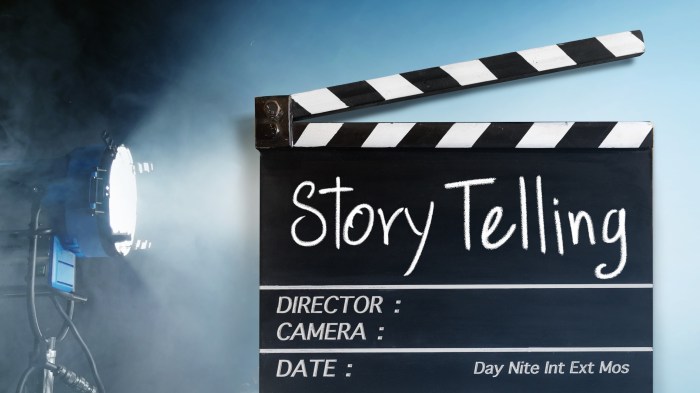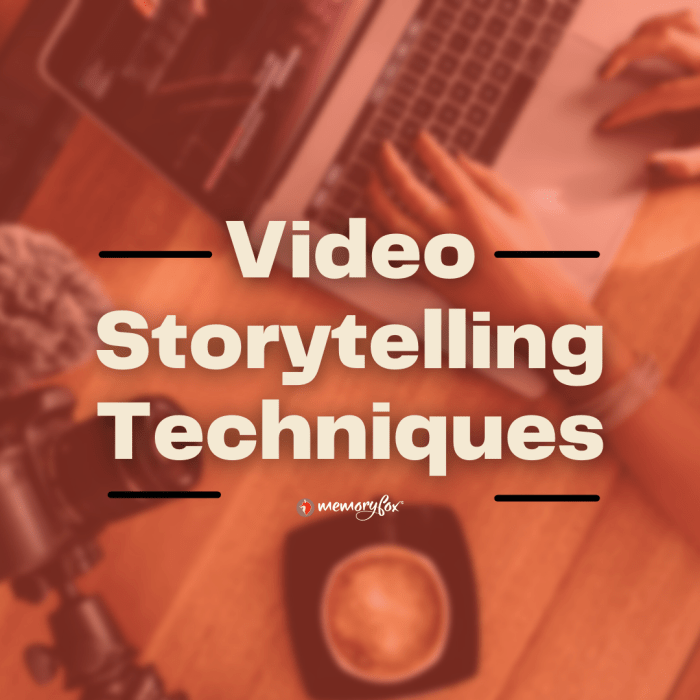Using Video Content for Storytelling dives into the world of visual storytelling through videos, capturing the essence of emotional connections and audience engagement in a dynamic and immersive way that resonates with viewers. From successful campaigns to creative strategies, this topic delves into the power of videos as a storytelling medium.
Introduction to Using Video Content for Storytelling

Storytelling through video content is a powerful way to engage and connect with audiences in today’s digital world. By combining visuals, audio, and narrative, videos can convey emotions, messages, and information in a compelling and memorable way.
Using videos for storytelling purposes is crucial for brands, businesses, and content creators looking to make a lasting impact. Videos have the ability to evoke strong emotions, create brand awareness, and drive action among viewers. They offer a dynamic and interactive way to share stories, showcase products, and communicate key messages.
Examples of Successful Video Storytelling Campaigns
- Dove’s “Real Beauty Sketches” campaign challenged societal perceptions of beauty and self-image, sparking conversations and promoting self-confidence.
- Nike’s “Dream Crazy” featuring Colin Kaepernick was a bold and impactful video that addressed social issues and inspired audiences to stand up for their beliefs.
- Google’s “Year in Search” videos effectively captured the essence of each year by highlighting the most searched topics and events, resonating with viewers on a global scale.
Benefits of Using Video Content for Storytelling
Video content has the power to evoke emotions in storytelling, creating a more immersive and impactful experience for the audience. Through visual and auditory elements, videos can bring stories to life, making viewers feel connected to the narrative on a deeper level.
Emotional Connection:
- Videos can portray facial expressions, body language, and tone of voice, allowing viewers to empathize with characters and their experiences.
- Background music, sound effects, and visual cues can evoke specific emotions, enhancing the overall storytelling experience.
- By tapping into emotions, videos can create a memorable and lasting impact on the audience, making the story more relatable and engaging.
Enhanced Engagement:
- Visual storytelling through videos can capture the audience’s attention more effectively than text or static images.
- Moving images and dynamic visuals can maintain viewer interest and encourage them to stay engaged with the story until the end.
- Interactive video content, such as clickable links or branching narratives, can further enhance engagement by allowing viewers to participate in the storytelling process.
Simplified Narratives:
- Complex ideas and concepts can be simplified and explained more clearly through visual aids and animations in videos.
- Visual metaphors, diagrams, and illustrations can help break down intricate information into digestible segments, making it easier for the audience to understand.
- By presenting information in a visual format, videos can streamline the storytelling process and make complex narratives more accessible to a wider audience.
Types of Video Content for Storytelling

Short films, animations, vlogs, and more are all different formats of video content that can be utilized for storytelling purposes. Each format brings a unique style and approach to conveying narratives, engaging viewers in various ways.
Live Videos for Immediate Storytelling
When it comes to creating a sense of immediacy in storytelling, live videos are a powerful tool. They allow creators to connect with their audience in real-time, fostering a deeper level of engagement and authenticity. Viewers feel like they are part of the story as it unfolds, creating a more immersive experience.
Role of Interactive Videos in Immersive Experiences
Interactive videos play a crucial role in providing immersive storytelling experiences. By allowing viewers to make choices or interact with the content, these videos engage the audience on a whole new level. Viewers become active participants in the story, shaping the narrative based on their decisions. This interactivity adds depth and personalization to the storytelling experience, making it more engaging and memorable.
Strategies for Effective Video Storytelling
Creating a compelling narrative arc in videos is crucial to keep viewers engaged from start to finish. Start with a strong hook to grab attention, build up the story with rising action, and conclude with a satisfying resolution.
The Importance of Visuals and Audio
Visuals and audio play a significant role in enhancing storytelling in videos. Use high-quality visuals to create a visually appealing experience for viewers and complement the narrative. Incorporate background music, sound effects, and voice-overs to evoke emotions and set the tone for the story.
- Choose relevant and captivating visuals that align with the story you are telling.
- Pay attention to audio quality to ensure clear and impactful sound that enhances the viewing experience.
- Experiment with different visual and audio techniques to create a unique and memorable storytelling experience.
Maintaining Authenticity and Transparency
Authenticity and transparency are key elements in video storytelling to build trust with your audience. Be genuine in your storytelling, share real experiences, and connect with viewers on a personal level.
Authenticity builds credibility and fosters a deeper connection with your audience.
- Avoid exaggeration or misleading information to maintain transparency and credibility.
- Share behind-the-scenes footage or personal anecdotes to show the human side of your story.
- Engage with your audience and encourage feedback to build a community around your storytelling.
Tools and Platforms for Video Storytelling: Using Video Content For Storytelling
Creating captivating storytelling videos requires the right tools and platforms to bring your vision to life. From video editing software to social media platforms, each element plays a crucial role in reaching your audience effectively.
Popular Video Editing Software
When it comes to crafting compelling video stories, having access to the right editing software is essential. Some popular options include Adobe Premiere Pro, Final Cut Pro, and iMovie. These tools offer a wide range of features to enhance your videos, from adding effects and transitions to adjusting color and sound.
Social Media Platforms for Sharing
Social media platforms serve as powerful channels for sharing your video stories with a wide audience. Platforms like YouTube, Instagram, Facebook, and TikTok provide opportunities to connect with viewers and build a community around your content. Utilize these platforms to engage with your audience and promote your storytelling videos effectively.
Utilizing Analytics for Success, Using Video Content for Storytelling
Measuring the success of your video storytelling campaigns is crucial for understanding what resonates with your audience. By utilizing analytics tools available on platforms like YouTube and social media insights, you can track metrics such as views, engagement, and demographics. Analyzing this data allows you to optimize your content strategy and create more impactful storytelling videos.
Case Studies: Successful Video Storytelling Examples
When it comes to effective video storytelling, brands have been leading the pack in creating compelling narratives that resonate with their audience. Let’s take a look at some successful examples of how brands have used video content to tell their stories.
Brands Utilizing Video Content
- Red Bull: Known for its extreme sports sponsorships, Red Bull has created a series of adrenaline-pumping videos that showcase the thrill-seeking lifestyle associated with their brand.
- Dove: Dove’s “Real Beauty” campaign has utilized video content to challenge traditional beauty standards and promote self-acceptance, resonating with audiences worldwide.
- Nike: Nike’s “Dream Crazy” campaign featuring Colin Kaepernick sparked conversations about social justice and empowerment, using video storytelling to make a powerful statement.
Non-Profit Organizations and Video Content
- UNICEF: UNICEF has effectively used video content to raise awareness about global issues such as child poverty and healthcare, inspiring viewers to take action and support their cause.
- Charity: Water: Through impactful storytelling videos, Charity: Water has been able to connect donors with the communities they are helping, showcasing the real impact of their contributions.
- WWF: The World Wildlife Fund has leveraged video content to highlight environmental conservation efforts and promote wildlife protection, engaging viewers in their conservation mission.
User-Generated Video Content Impact
- TikTok Challenges: User-generated video content on platforms like TikTok has led to viral challenges that not only entertain but also raise awareness about social issues or important causes, showing the power of user participation in storytelling.
- YouTube Reviews: User-generated video reviews on YouTube have influenced consumer decisions and shaped brand perceptions, demonstrating the impact of authentic user experiences on storytelling initiatives.
- Crowdsourced Campaigns: Brands like GoPro have successfully incorporated user-generated content into their marketing campaigns, showcasing authentic user experiences and stories to enhance brand authenticity and credibility.





